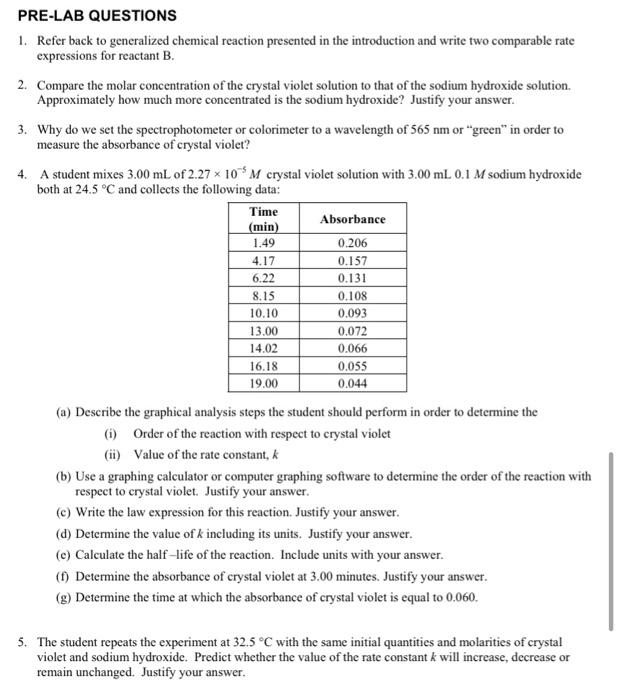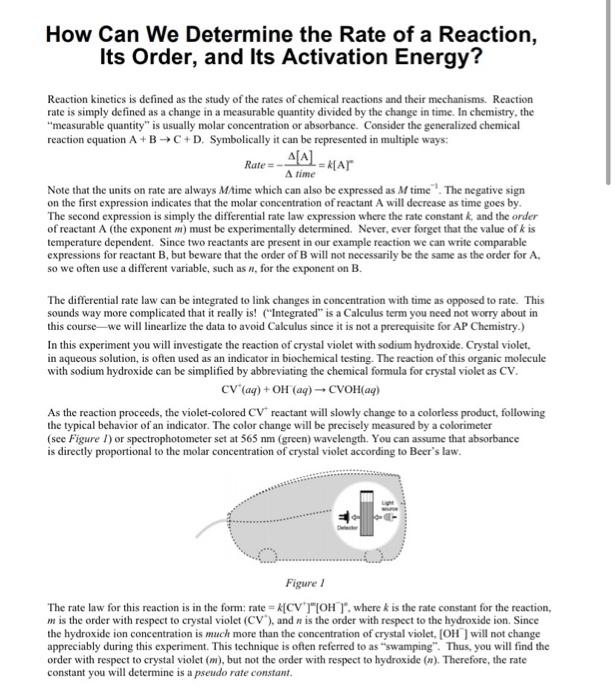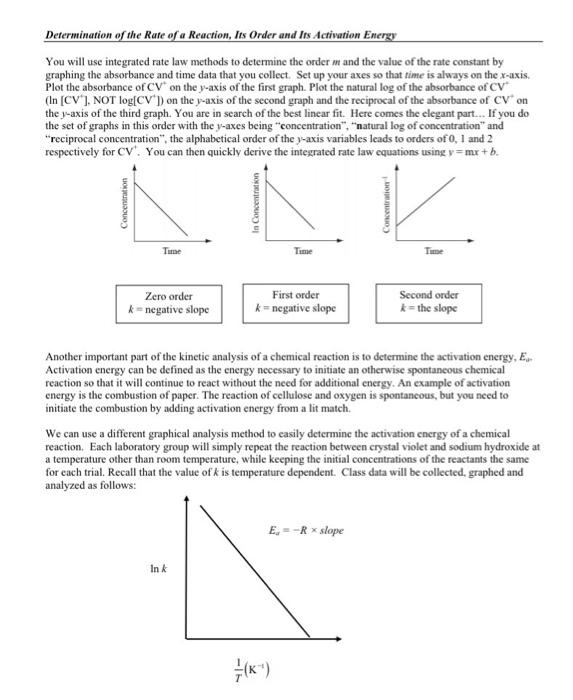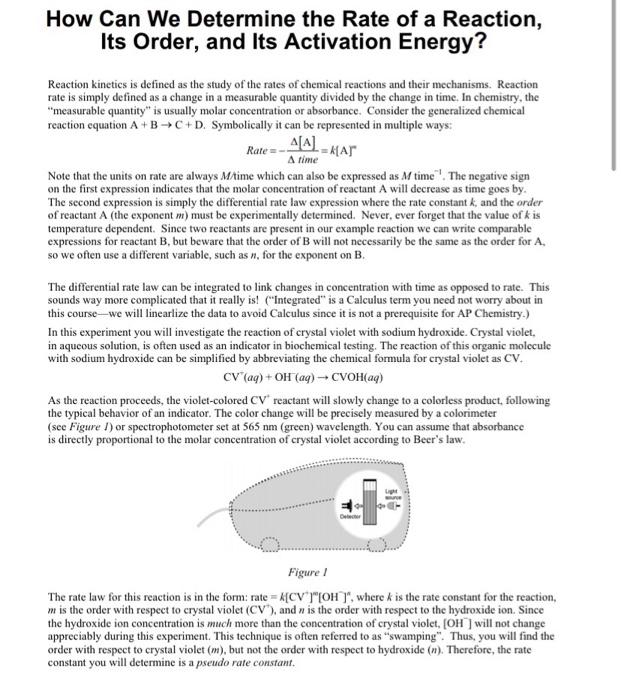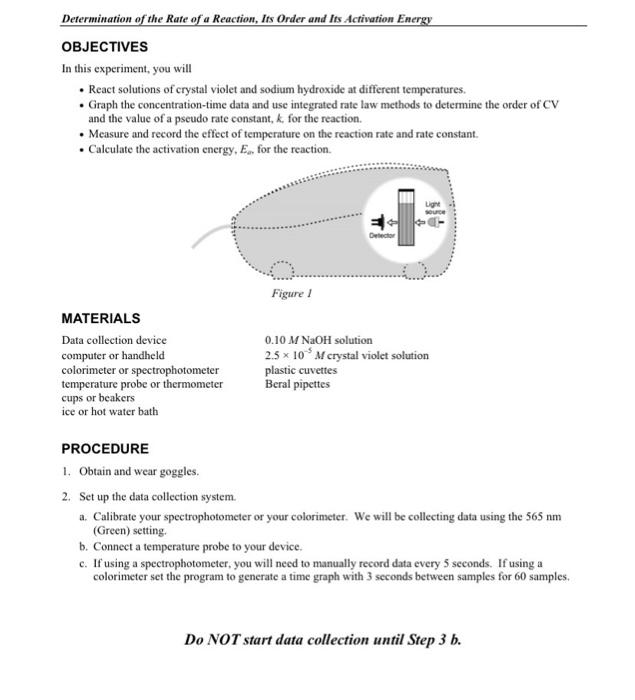Can anyone help me with 1-3 and number 5 please.
PRE-LAB QUESTIONS 1. Refer back to generalized chemical reaction presented in the introduction and write two comparable rate expressions for reactant B. 2. Compare the molar concentration of the crystal violet solution to that of the sodium hydroxide solution. Approximately how much more concentrated is the sodium hydroxide? Justify your answer. 3. Why do we set the spectrophotometer or colorimeter to a wavelength of 565 nm or "green" in order to measure the absorbance of crystal violet? 4. A student mixes 3.00 mL of 2.27 * 10M crystal violet solution with 3.00 mL 0.1 M sodium hydroxide both at 24.5 C and collects the following data: Time Absorbance (min) 1.49 0.206 4.17 0.157 6.22 0.131 8.15 0.108 10.10 0.093 13.00 14.02 0.066 16.18 0.055 19.00 0.044 (a) Deseribe the graphical analysis steps the student should perform in order to determine the (i) Order of the reaction with respect to crystal violet (ii) Value of the rate constant, k (b) Use a graphing calculator or computer graphing software to determine the order of the reaction with respect to crystal violet. Justify your answer. (C) Write the law expression for this reaction. Justify your answer. (d) Determine the value of k including its units. Justify your answer. () Calculate the half-life of the reaction. Include units with your answer. (1) Determine the absorbance of crystal violet at 3.00 minutes. Justify your answer. (9) Determine the time at which the absorbance of crystal violet is equal to 0.060. 0.072 5. The student repeats the experiment at 32.5C with the same initial quantities and molarities of crystal violet and sodium hydroxide. Predict whether the value of the rate constant k will increase, decrease or remain unchanged. Justify your answer. How Can We Determine the Rate of a Reaction, Its Order, and Its Activation Energy? Reaction kinetics is defined as the study of the rates of chemical reactions and their mechanisms. Reaction rate is simply defined as a change in a measurable quantity divided by the change in time. In chemistry, the "measurable quantity" is usually molar concentration or absorbance. Consider the generalized chemical reaction equation A+B+C + D. Symbolically it can be represented in multiple ways: Rate = A[A] = a[ar A time Note that the units on rate are always Mtime which can also be expressed as M time. The negative sign on the first expression indicates that the molar concentration of reactant A will decrease as time goes by The second expression is simply the differential rate law expression where the rate constant k, and the order of reactant A (the exponent ) must be experimentally determined. Never, ever forget that the value of k is temperature dependent. Since two reactants are present in our example reaction we can write comparable expressions for reactant B, but beware that the order of B will not necessarily be the same as the order for A. so we often use a different variable, such as ni, for the exponent on B. The differential rate law can be integrated to link changes in concentration with time as opposed to rate. This sounds way more complicated that it really is! ("Integrated" is a Calculus term you need not worry about in this course we will linearlize the data to avoid Calculus since it is not a prerequisite for AP Chemistry.) In this experiment you will investigate the reaction of crystal violet with sodium hydroxide. Crystal violet. in aqueous solution, is often used as an indicator in biochemical testing. The reaction of this organic molecule with sodium hydroxide can be simplified by abbreviating the chemical formula for crystal violet as CV. CV (aq) + OH (aq) -- CVOH(aq) As the reaction proceeds, the violet-colored CV reactant will slowly change to a colorless product, following the typical behavior of an indicator. The color change will be precisely measured by a colorimeter (see Figure 1) or spectrophotometer set at 565 nm (green) wavelength. You can assume that absorbance is directly proportional to the molar concentration of crystal violet according to Beer's law. Figure The rate law for this reaction is in the form: rate = [CV TOH)", where is the rate constant for the reaction, m is the order with respect to crystal violet (CV), and n is the order with respect to the hydroxide ion. Since the hydroxide ion concentration is much more than the concentration of crystal violet. (OH) will not change appreciably during this experiment. This technique is often referred to as "swamping". Thus, you will find the order with respect to crystal violet (m), but not the order with respect to hydroxide (). Therefore, the rate constant you will determine is a pseudo rate constant. Determination of the Rate of a Reaction, Its Order and Its Activation Energy You will use integrated rate law methods to determine the order and the value of the rate constant by graphing the absorbance and time data that you collect. Set up your axes so that time is always on the x-axis. Plot the absorbance of CV on the y-axis of the first graph. Plot the natural log of the absorbance of CV (In (CV), NOT log[CV) on the y-axis of the second graph and the reciprocal of the absorbance of CV on the y-axis of the third graph. You are in search of the best linear fit. Here comes the elegant part... If you do the set of graphs in this order with the y-axes being concentration", "natural log of concentration" and "reciprocal concentration", the alphabetical order of the y-axis variables leads to orders of 0, 1 and 2 respectively for CV. You can then quickly derive the integrated rate law equations using v=mx+b. AAR Time Zero order * = negative slope First order k = negative slope Second order k-the slope Another important part of the kinetic analysis of a chemical reaction is to determine the activation energy, E. Activation energy can be defined as the energy necessary to initiate an otherwise spontaneous chemical reaction so that it will continue to react without the need for additional energy. An example of activation energy is the combustion of paper. The reaction of cellulose and oxygen is spontaneous, but you need to initiate the combustion by adding activation energy from a lit match. We can use a different graphical analysis method to easily determine the activation cnergy of a chemical reaction. Each laboratory group will simply repeat the reaction between crystal violet and sodium hydroxide at a temperature other than room temperature, while keeping the initial concentrations of the reactants the same for each trial. Recall that the value of k is temperature dependent. Class data will be collected graphed and analyzed as follows: E. --R* slope Ink (1) How Can We Determine the Rate of a Reaction, Its Order, and Its Activation Energy? Reaction kinetics is defined as the study of the rates of chemical reactions and their mechanisms. Reaction rate is simply defined as a change in a measurable quantity divided by the change in time. In chemistry, the "measurable quantity" is usually molar concentration or absorbance. Consider the generalized chemical reaction equation A+B+C+D. Symbolically it can be represented in multiple ways: Rate A[A] -=[AT A time Note that the units on rate are always M time which can also be expressed as a time. The negative sign on the first expression indicates that the molar concentration of reactant A will decrease as time goes by The second expression is simply the differential rate law expression where the rate constant k, and the order of reactant A (the exponent m) must be experimentally determined. Never, ever forget that the value of k is temperature dependent. Since two reactants are present in our example reaction we can write comparable expressions for reactant B, but beware that the order of B will not necessarily be the same as the order for A. so we often use a different variable, such as n, for the exponent on B. The differential rate law can be integrated to link changes in concentration with time as opposed to rate. This sounds way more complicated that it really is! ("Integrated" is a Calculus term you need not worry about in this course we will linearlize the data to avoid Calculus since it is not a prerequisite for AP Chemistry.) In this experiment you will investigate the reaction of crystal violet with sodium hydroxide. Crystal violet. in aqueous solution, is often used as an indicator in biochemical testing. The reaction of this organic molecule with sodium hydroxide can be simplified by abbreviating the chemical formula for crystal violet as CV. CV'(aq) + OH(aq) - CVOH(aq) As the reaction proceeds, the violet-colored CV reactant will slowly change to a colorless product, following the typical behavior of an indicator. The color change will be precisely measured by a colorimeter (see Figure 1) or spectrophotometer set at 565 nm (green) wavelength. You can assume that absorbance is directly proportional to the molar concentration of crystal violet according to Beer's law. Figure The rate law for this reaction is in the form: rate=K[CV (OH)", where k is the rate constant for the reaction, m is the order with respect to crystal violet (CV), and n is the order with respect to the hydroxide ion. Since the hydroxide ion concentration is much more than the concentration of crystal violet, (OH) will not change appreciably during this experiment. This technique is often referred to as swamping". Thus, you will find the order with respect to crystal violet (m), but not the order with respect to hydroxide (n). Therefore, the rate constant you will determine is a pseudo rate constant. Determination of the Rate of a Reaction, Its Order and its Activation Energy OBJECTIVES In this experiment, you will React solutions of crystal violet and sodium hydroxide at different temperatures. Graph the concentration-time data and use integrated rate law methods to determine the order of CV and the value of a pseudo rate constant, k for the reaction. Measure and record the effect of temperature on the reaction rate and rate constant. Calculate the activation energy, E, for the reaction. Figure MATERIALS Data collection device computer or handheld colorimeter or spectrophotometer temperature probe or thermometer cups or beakers ice or hot water bath 0.10 M NaOH solution 2.5 10M crystal violet solution plastic cuvettes Beral pipettes PROCEDURE 1. Obtain and wear goggles. 2. Set up the data collection system. a. Calibrate your spectrophotometer or your colorimeter. We will be collecting data using the 565 nm (Green) setting b. Connect a temperature probe to your device. c. If using a spectrophotometer, you will need to manually record data every 5 seconds. If using a colorimeter set the program to generate a time graph with 3 seconds between samples for 60 samples. Do NOT start data collection until Step 3 b
